Sacred Groves in China
Air Date: Week of October 27, 2023
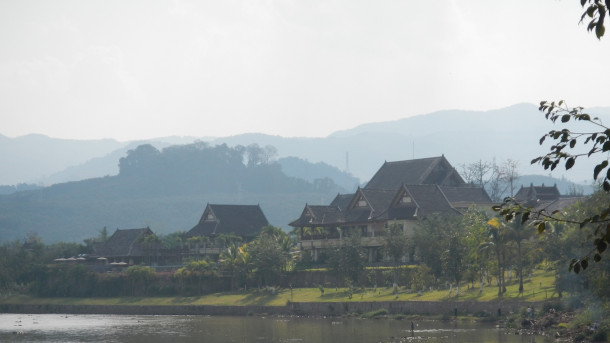
This Holy Hill in the Dai village of Chengzi, surrounded by monoculture rubber plantations, contains tall old-growth trees. (Photo: Lily Zeng)
In the Yunnan Province in Southwest China, generations of locals have protected sacred forest groves that some consider the homes of the spirits of their ancestors. Lily Zeng researched these “holy hills” as part of her doctoral studies at Yale School of the Environment and she joined Living on Earth’s Bobby Bascomb to describe them.
Transcript
DOERING: “Creation care” is just another name for the environmental stewardship that the faithful have been doing for thousands of years in many different traditions around the world. In the Yunnan Province in Southwest China, locals have protected sacred forest groves that some consider the homes of the spirits of their ancestors. Lily Zeng researched these “holy hills” as part of her doctoral studies at Yale School of the Environment and she joined Living on Earth’s Bobby Bascomb to describe them.
BASCOMB: So for someone who's never been to this part of China, can you describe for us, please, the holy hills? What's so special about the area?
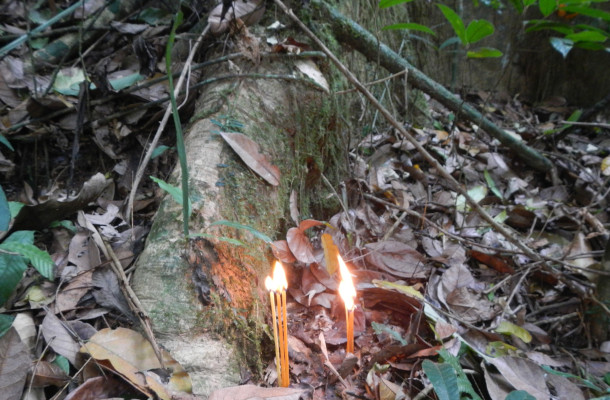
Before Dr. Zeng and her team conducted biological surveys in this Holy Hill in the village of Chengzi, the village shaman burned traditional incense and asked for the Holy Hill spirit’s blessing. (Photo: Lily Zeng)
ZENG: So I work in a region of China called Xishuangbanna, which is in the southwest corner, right on the border of Laos and Myanmar. It's a really special area in terms of the biodiversity there. Even though this prefecture is only 0.2%, of China's land area, it has 16% of China's biodiversity in terms of its plants. It also has 22% of China's mammals, 15% of China's reptiles and amphibians, and many of these species are found nowhere else in China. It's also really special because of the high cultural diversity. So China officially has 56 ethnic groups. So it's 55 minorities plus the dominant Han, and 75% of the people here are ethnic minorities. So you can see it's just such a special part of China. And then the holy hills are really an important part of this region, because this region has been going through a lot of change. These forests have been converted to monoculture rubber plantations. In the face of all this very rapid conversion, some of the only remnants of tropical rainforest that you find outside of the state protected nature reserves are these patches of forest that are protected by ethnic minorities slash indigenous groups for religious and cultural reasons.
BASCOMB: And I understand that you traveled there. What does it feel like for you to be there?
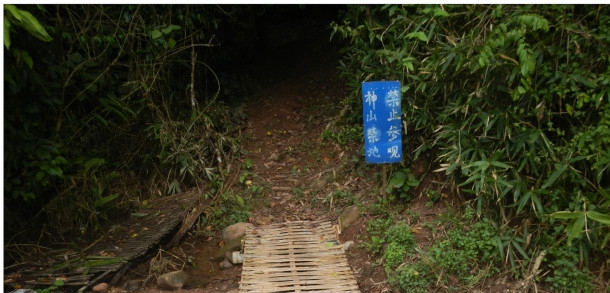
The sacred forest in the village of Manlang was cut down during the Cultural Revolution of the 1970s. When policies changed in the 1980s, the village consecrated a patch of land and let trees start to grow back. (Photo: Lily Zeng)
ZENG: Yeah, holy hills are amazing spaces. And they're also really different. Some of the ones I've been in are fairly curated. So you have a beautiful statue in the middle. And then they have these old tall trees. And it almost feels like being in a church except made of trees. And then you have other ones that are more, I guess, forests in the way that we think of them, except this is in a tropical ecosystem. So they're basically jungles. And there are lianas, and lots of plants that have formed and it's very ouch. [LAUGH]
BASCOMB: And the name holy hill, I'm assuming that they're actually hills, or small mountains that we're talking about.
ZENG: I would say that they're more isolated fragments of forest. The name of holy hill was coined by a famous, the father of Chinese ethnobotany, who's named Pei Shengji, and he's a wonderful man, who I respect tremendously. This was his English name for them. But really, their defining feature I would think, is that the communities have consecrated this patch of land to be the home to their ancestral spirits.
BASCOMB: So tell me more about the local people that live around the Holy Hills and their relationship with the land.
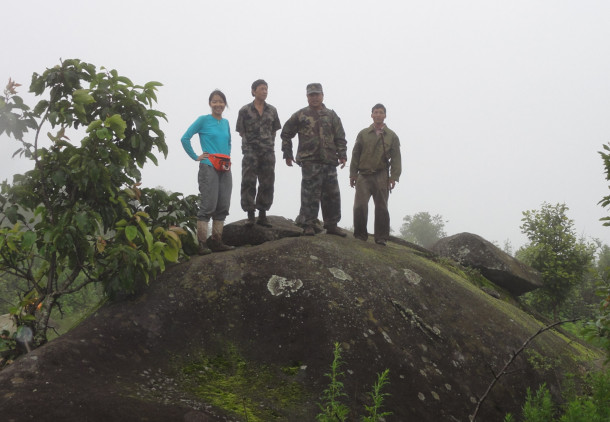
Women are traditionally forbidden from entering Holy Hills, but with special permission, Dr. Zeng was allowed to conduct biological surveys in the area. (Photo: Courtesy of Lily Zeng)
ZENG: So these Holy Hills are sacred spaces, where entry is often forbidden. For instance, one of the most common taboos is that women are not allowed to enter this sacred space. So obviously, as a female researcher working on this, that presented a number of challenges. So I know for a fact that there are a number of rituals associated with it. For instance, it often involves an animal sacrifice, depending on the village. It could mean, chickens, it could mean a pig. And then the bomo, so the shaman, will bring the animal sacrifice in and then the men of the village will go participate. And there are a number of rituals to ask the spirit in terms of how's the village doing, in terms of various aspects of well being, I can't actually tell you about what that looks like, because I wasn't allowed to join. But I saw a few pictures. There's often this idea that because holy are an old cultural tradition, that it has to reference old things. But this actually is a part of everyday life, in contemporary life. So for instance, many Dai communities I work with right now, their main source of income is rubber. And so even as I was speaking early on, I know that there's this idea of the tendency to have the dichotomy between protecting the forests versus economic development for rubber. But in fact, this community I was working with, they were praying to their Holy Hill spirit to protect their rubber plantations.
BASCOMB: If there's been so much development around these Holy Hills, to what degree is a sacred grove, are these Holy Hills completely untouched by people, you know, pristine, old growth forest? Or is the concept of sacred or holy more nuanced than that? Can it change?
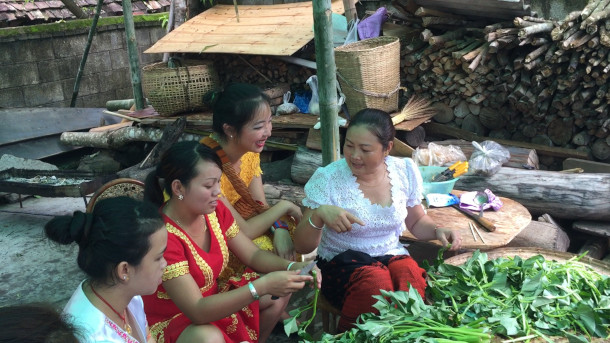
Dr. Zeng interviews Dai women while they prepare food. (Photo: Courtesy of Lily Zeng)
ZENG: I think one of the really cool things about sacred forests in general, not only Holy Hills, is that they're really seen as a way to not only protect biodiversity, because these often tend to be located in ecosystems that are underrepresented in protected areas, but also to marry conservation goals with social benefits for local communities. Many people see sacred forests as an alternative to fortress conservation approaches, which is something that speaks to the idea of pristine nature that you mentioned in terms of preserving nature through the forceful exclusion of people, which often has unfortunate consequences for the communities and people surrounding a piece of nature that is being protected. One of the things that my research was showing was how some of these forests were, if you just do your ecological survey, you might say, wow, this is a fragmented forest that looks like it's been degraded. And it shows how these fragmented forests really aren't able to maintain levels of biodiversity comparable with nature reserves, yada yada yada. Whereas one of the forests that I was with in the village of Manlang, it was really cool because I was learning from my time there, that this particular Holy Hill had been cut down and planted with commercial firewood trees during the Cultural Revolution in the 1970s. And then, when the policies changed in the 80s, Manlang recreated this sacred forest by consecrating a patch of land and letting the forests grow back, and then what I thought was so amazing, with all the emphasis on conservation, on preserving forest, it was so remarkable that after a forest was destroyed, it could be resurrected through a community's connection with the sacred. And so when I asked for permission to enter this particular Holy Hill to conduct the botanical surveys, the community leadership initially was very reluctant, mainly because women are traditionally forbidden to enter Holy Hills. But ultimately, this particular village allowed my botanical surveys in return for me providing some tree seedlings with support from Xishuangbanna Tropical Botanical Garden in order to help restore their Holy Hill. And it was really, really a huge honor and so special for me, because then I became the first and only female who had ever set foot in this particular Holy Hill.
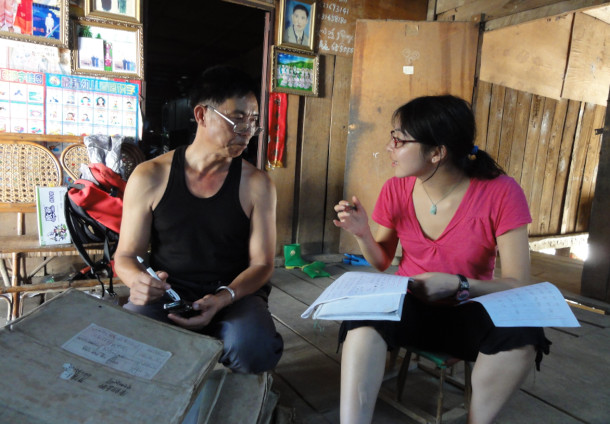
Dr. Zeng conducts an interview with a village elder. (Photo: Courtesy of Lily Zeng)
BASCOMB: And so what was it like once you were there?
ZENG: Because this was a forest that had previously been planted with other things and then cut down, it wasn't the same kind of forest you think of with like, wow, this tree is 500 years old, and you could drive a car through it. It was special because of what I knew the forest had represented and the layers of meaning that I knew were embedded in the trees I saw around me.
DOERING: That’s Yale scholar Lily Zeng speaking with Living on Earth’s Bobby Bascomb.
Links
Living on Earth wants to hear from you!
Living on Earth
62 Calef Highway, Suite 212
Lee, NH 03861
Telephone: 617-287-4121
E-mail: comments@loe.org
Newsletter [Click here]
Donate to Living on Earth!
Living on Earth is an independent media program and relies entirely on contributions from listeners and institutions supporting public service. Please donate now to preserve an independent environmental voice.
NewsletterLiving on Earth offers a weekly delivery of the show's rundown to your mailbox. Sign up for our newsletter today!
 Sailors For The Sea: Be the change you want to sea.
Sailors For The Sea: Be the change you want to sea.
 The Grantham Foundation for the Protection of the Environment: Committed to protecting and improving the health of the global environment.
The Grantham Foundation for the Protection of the Environment: Committed to protecting and improving the health of the global environment.
 Contribute to Living on Earth and receive, as our gift to you, an archival print of one of Mark Seth Lender's extraordinary wildlife photographs. Follow the link to see Mark's current collection of photographs.
Contribute to Living on Earth and receive, as our gift to you, an archival print of one of Mark Seth Lender's extraordinary wildlife photographs. Follow the link to see Mark's current collection of photographs.
 Buy a signed copy of Mark Seth Lender's book Smeagull the Seagull & support Living on Earth
Buy a signed copy of Mark Seth Lender's book Smeagull the Seagull & support Living on Earth

